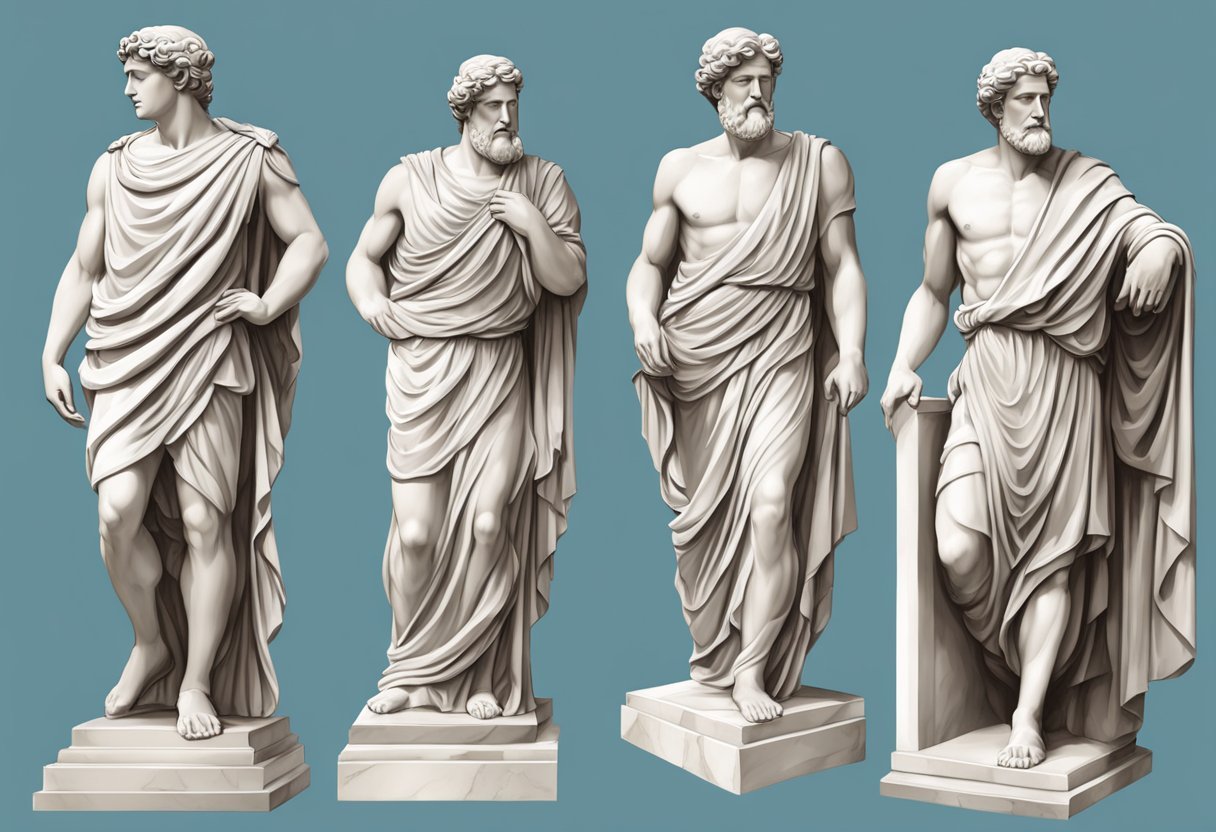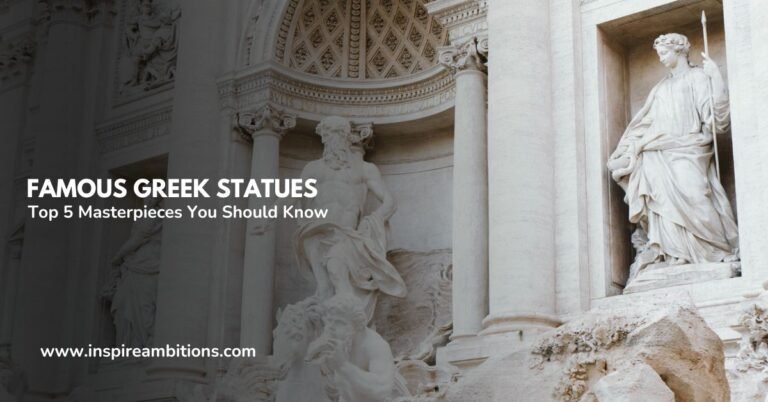Greek Statues – Ancient Marvels of Mediterranean Art
Greek statues are timeless masterpieces that continue to captivate and inspire. You might wonder why these ancient works of art hold such enduring appeal. Ancient Greek sculpture represents the pinnacle of classical art, embodying ideals of beauty, proportion, and human form that have influenced Western art for millennia.

When you gaze upon a Greek statue, you’re looking at more than just carved stone. Each piece tells a story, whether it’s of gods, heroes, or everyday people. The sculpture of ancient Greece spans several periods, from the Archaic to the Hellenistic, each with its distinct style and characteristics.
You’ll find that Greek statues aren’t just about aesthetics. They offer a window into the culture, beliefs, and values of ancient Greek society. From the powerful Zeus to the graceful Aphrodite, these sculptures bring mythology to life. They also showcase the remarkable skill of Greek artists, who could make marble appear as soft as flesh and as fluid as fabric.
Historical Context and Evolution
Greek sculpture evolved dramatically over centuries, reflecting the changing values and artistic techniques of ancient civilizations. This art form transformed from rigid, stylized figures to lifelike masterpieces that continue to inspire today.
Origins and Archaic Period
The roots of Greek sculpture trace back to the Archaic period, spanning from 800 to 480 BCE. Early works drew inspiration from Egyptian and Near Eastern monumental art. Sculptors crafted kouroi and korai – idealized male and female figures with stiff poses and enigmatic “archaic smiles.”
These statues served religious and commemorative purposes. Artists worked primarily in limestone and marble, gradually developing techniques to capture more natural forms. The period saw a shift from flat, geometric designs to more rounded, three-dimensional figures.
By the late Archaic era, sculptors began experimenting with contrapposto – a more relaxed, asymmetrical stance that would revolutionize future works.
Classical Period Mastery
The Classical period (480-323 BCE) they have marked the pinnacle of Greek sculptural achievement. Artists perfected their craft, creating stunningly lifelike figures with idealized proportions and anatomical accuracy.
Key developments included:
- Mastery of the contrapposto pose
- Refined facial expressions
- Intricate drapery techniques
- Use of bronze for larger, more dynamic sculptures
Famous works like the Parthenon frieze and Myron’s Discobolus exemplified the era’s focus on harmony, balance, and human perfection. Sculptors like Phidias and Polykleitos established canons of proportion that influenced art for centuries.
Hellenistic Period Innovations
The Hellenistic period (323-31 BCE) ushered in new artistic freedoms. Sculptors moved beyond idealized forms, exploring a more comprehensive range of subjects and emotions. You’ll notice:
- Dramatic, twisted poses
- Intense facial expressions
- Diverse subjects, including children and the elderly
- Heightened realism and individualized features
Iconic works like the Venus de Milo and the Winged Victory of Samothrace showcase the period’s dynamism and technical mastery. Artists pushed boundaries, creating sculptures meant to be viewed from multiple angles and experimenting with elaborate groupings.
Hellenistic sculptors also embraced new materials and techniques, including the use of coloured marble and intricate surface textures to enhance realism.
Iconic Sculptures and Sculptors
Greek statues represent some of the most influential and admired artworks in history. These masterpieces showcase the skill and creativity of ancient sculptors, leaving a lasting impact on art and culture.
Masterpieces of the Ancient World
The Statue of Zeus at Olympia stood as one of the Seven Wonders of the Ancient World. This colossal chryselephantine sculpture, created by Phidias, depicted the king of gods seated on a throne.
Another iconic work is the Aphrodite of Knidos, sculpted by Praxiteles. This statue revolutionized the depiction of the female form in Greek art, presenting the goddess in a natural, sensual pose.
The Parthenon frieze, a continuous sculptural decoration adorning the famous temple, exemplifies the height of Classical Greek art. Its intricate carvings depict religious processions and mythological scenes.
Renowned Greek Sculptors
Phidias, considered one of the greatest sculptors of ancient Greece, is best known for his monumental works. His most famous creations include the aforementioned Statue of Zeus and the Athena Parthenos in the Parthenon.
Myron gained fame for his dynamic bronze sculptures, particularly the Discobolus or “Discus Thrower.” This piece captures the moment of athletic tension before the release of the discus.
Polykleitos developed the Doryphoros or “Spear Bearer”, which exemplified his canon of ideal proportions for the male figure. This work became a standard for later sculptors.
Lysippos, known for his naturalistic style, created numerous portraits of Alexander the Great. His works influenced the development of Hellenistic sculpture.
Artistic Techniques and Materials
Greek sculptors employed various materials and methods to create lifelike masterpieces. Their techniques evolved, leading to more realistic and dynamic representations of the human form.
Sculpting Materials and Methods
Marble and bronze were the primary materials used in ancient Greek sculpture. Marble, especially Parian marble, was prized for its pure white colour and fine grain. Bronze allowed for more complex poses and thinner elements.
Sculptors also worked with terracotta, ivory, and wood. Limestone served as a cheaper alternative to marble. Gold was often used for decorative elements or entire statues of deities.
The sphyrelaton technique involved hammering metal sheets and attaching them with rivets. This method gradually gave way to lost wax casting for bronze sculptures.
Artisans painted and polished their works to enhance realism. Many sculptures that appear plain today were once vibrantly coloured.
Advances in Sculptural Form and Realism
Greek sculptors made significant strides in depicting the human body accurately. They studied anatomy closely to capture muscles, bones, and proportions realistically.
The Classical period saw a focus on idealized beauty and balanced proportions. Sculptors like Polykleitos developed mathematical systems for perfect human forms.
Later Hellenistic works embraced more dynamic poses and emotional expressions. The famous Laocoön sculpture exemplifies this trend with its dramatic movement and intense facial expressions.
Artists mastered techniques to show different textures, from soft skin to flowing drapery. They created the illusion of movement through subtle shifts in weight and carefully positioned limbs.
Cultural Significance and Representation
Ancient Greek statues held immense cultural importance, serving as powerful symbols of religious devotion and civic pride. These masterpieces reflected the values, beliefs, and ideals of Greek society, shaping public spaces and sacred sites across the Hellenic world.
Depiction of Deities and Mythology
Greek sculptors brought mythological figures to life through their artistry. You’d find majestic statues of Zeus, wise Athena, and beautiful Aphrodite adorning temples and public squares. These representations helped people visualize and connect with their gods.
Sculptors captured the essence of each deity’s character. Apollo embodied youthful perfection, while Dionysus exuded sensuality. Warriors and athletes were often depicted to showcase ideal human forms.
Greek myths came alive through sculpture. You could see stories of heroes and legends frozen in marble, allowing you to immerse yourself in the rich tapestry of Greek mythology.
Sculpture in Public and Sacred Spaces
Greek sculptures transformed cities like Athens, Olympia, and Delphi into open-air galleries. You’d encounter statues in marketplaces, theatres, and government buildings, each piece contributing to the city’s identity and prestige.
Temples housed colossal cult statues, like the 12-meter-high golden Athena Parthenos in the Parthenon. These awe-inspiring works reinforced religious devotion and civic pride.
Public monuments celebrate historical figures and events. You might see statues of Alexander the Great or victorious athletes serving as reminders of Greek achievements and values.
Sculptures in sacred spaces created an atmosphere of reverence. As you approach a temple, you’d be greeted by intricate friezes and pediments, setting the stage for worship and contemplation.






